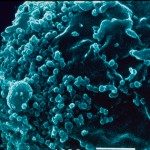Link to Pubmed [PMID] – 11531954
Clin. Exp. Immunol. 2001 Sep;125(3):455-64
In utero transmission of HIV-1 has been demonstrated and may account for around 10-20% of all materno-fetal HIV-1 transmission. The possible routes for such transmission are transannexial or transplacental. In both cases, the microenvironment (cytokines and chemokines) at the placental interface could be an important regulatory factor in viral transmission. We therefore performed explant cultures of placental villi, and isolated purified trophoblasts, from term placentae obtained from HIV-1-seropositive and HIV-1-seronegative women in order to assess and compare the cytokine and chemokine secretion profiles using ELISA and semiquantitative RT-PCR. No major differences could be seen in the secretions of cytokines and chemokines at the level of whole placental tissue in HIV-1-positive and HIV-1-negative women. However, variations were observed in the expression of inflammatory cytokines and chemokines from trophoblastic cells, depending on the status of HIV-1 infection of the mothers but not the babies, all of which remained uninfected. The significance of these data is discussed.

